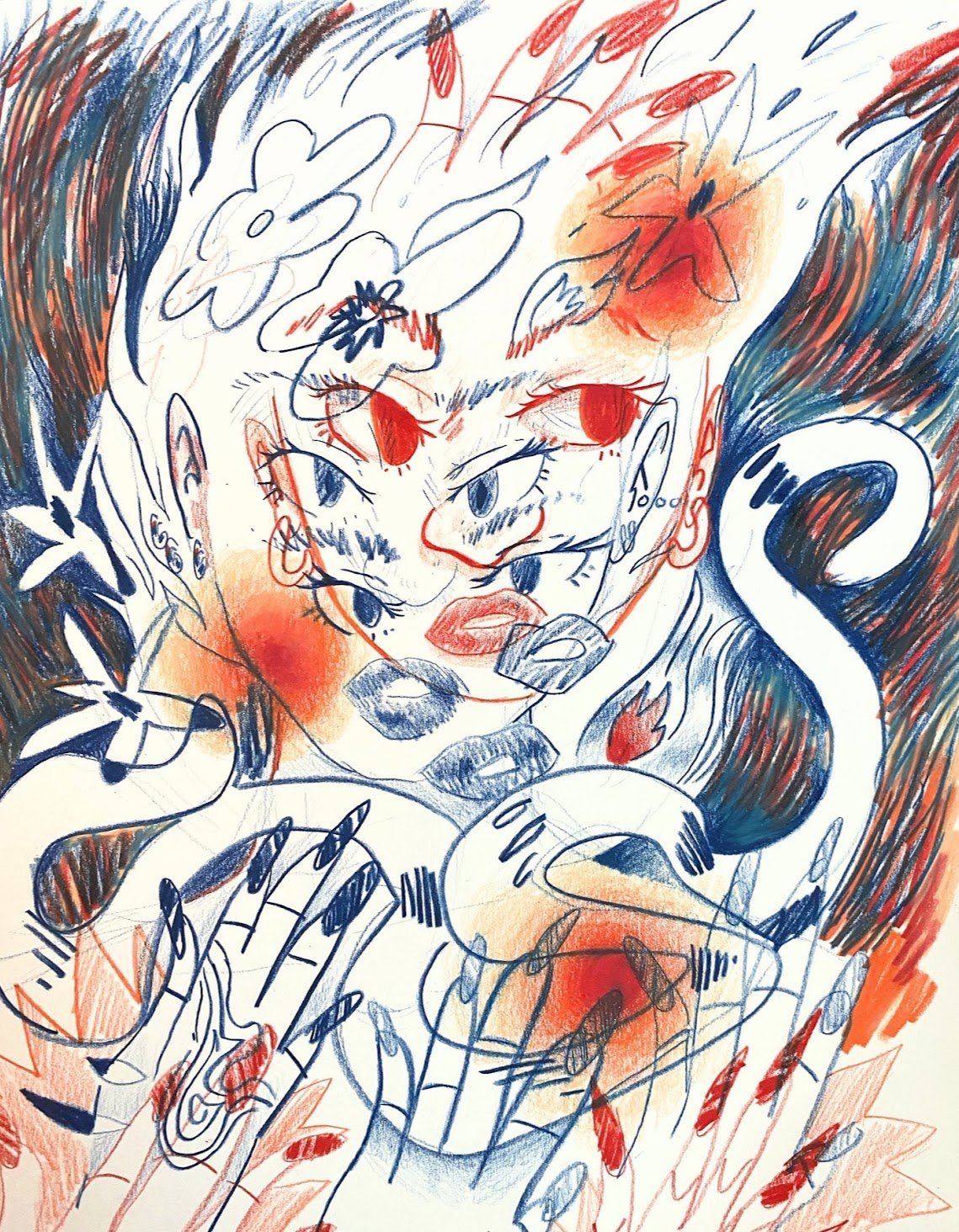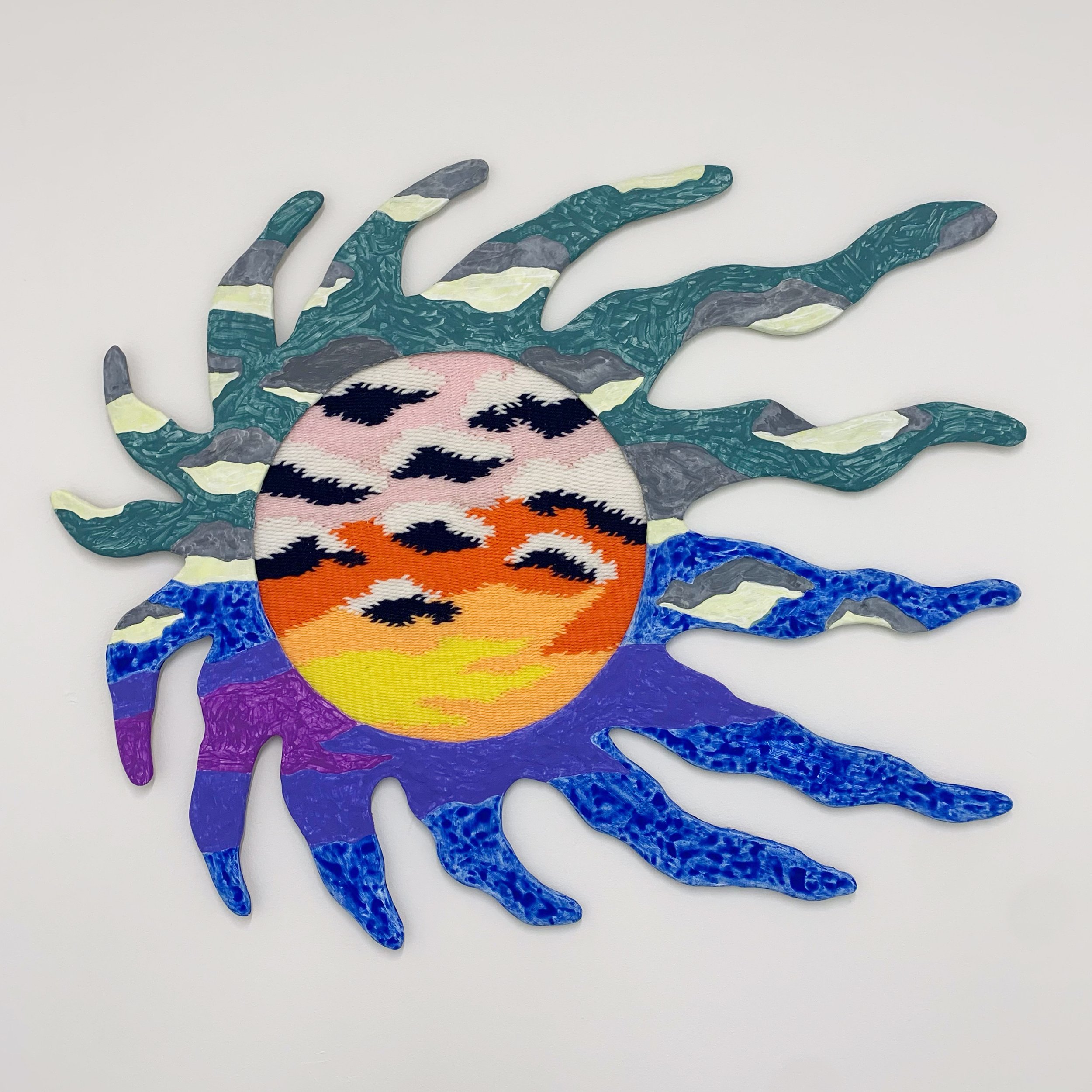ROY presents: Phoenix S. Brown, Morgan Rose Free + Padyn Humble
Phoenix S. Brown
Metamorphose
I am an interdisciplinary artist who makes paintings with elements of drawing, collage, and printmaking. Using diverse disciplines and materials allows me to disrupt and reclaim western conventions of painting as a woman of color. By doing this, my work challenges western portraiture and preconceived notions of the Black female body. With contemporary material and aesthetic choices, I subvert the one-way window of fantasy that western painting has long offered.
Throughout art history, nature and Blackness have existed as reserves to exploit; in my work, they blend and force us to confront our viewing access to them. I conceal and reveal parts of figures to introduce dialogues of voyeurism and fetishization. By abstracting representations of nature, I make botanical classification, a European construct, impossible to employ when foliage resists visual specificity. Instead, the presence of nature signals a fantastical, safe space where I allow myself to unravel personal reflections cryptically. My work grapples with the disconnect between reality and euro-centric narratives of Blackness, womanhood, and the natural world.
There is a feedback loop between my analog painting and digital editing visible in the final image. My interdisciplinary paintings are layered with impossible brush strokes from their time in digital drawing software and maintain a textured surface that speaks to the western art canon. I use technology and various modes of making to build contemporary reimaginations of utopias and resistances where Black womanhood is free from stereotypes, fetishes, and the white male gaze.
ROY asks
What is your name and preferred pronouns?
She/Her
How has art (whether it be your own or art in general) changed you?
Art has influenced how I interpret current events, history, and popular culture. Through art, I’ve learned to think critically and question everything.
How did you start your artistic practice?
As a kid, I watched too much TV and learned how to draw through watching cartoons (e.g., Powerpuff Girls, Ed, Edd n Eddy, The Grim Adventures of Billy and Mandy, etc.). I also enjoyed writing short stories and drawing comics as a pastime; all the characters required a superpower and a love-story subplot, haha. Later down the line, I got a little more serious when I attended the School for Creative and Performing Arts in Cincinnati for high school as a Visual Arts major. I learned how to use acrylic paint, prep canvases, and make consistent bodies of work. To this day, I prefer to draw cartoonish figures and abstract shapes similar to onamonapias. Sometimes I feel like an illustrator-writer with formal concerns for surface and critique (to put it simply).
When a first-time viewer sees your work, what is the first word that you hope they think when looking at it?
I hope viewers experience something new every time they return to my work, whether a small detail or a broken narrative. As an artist who paints and draws abstractly, I learned to let go of how the audience will interpret my work. I create intuitively and make what I want to make.
Thank you to Alive for drawing attention to Phoenix’s work
Morgan Rose Free + Padyn Humble
A DOVE IS JUST A WHITE PIGEON
Morgan Rose Free and Padyn Humble’s practices are both concerned with some form of human engagement and cultural constructions. Be it within a social, political, or climate condition; both artists investigate how these areas are affected once they intersect with the obligations and expectations of our sociological environment. Free’s conceptual interests lie in human engagement with the outside world, often grappling with ideas around our current climate crisis, engagement with public spaces (both natural and human made), and how the digital age has affected these relationships. Humble’s work exists in a crux of absurdity, sincerity, and humor that reveals the complex way we are defined or perceived through the norms that pervade our social worlds. Whether critiquing or simply investigating, there is an underlying tone of sardonic reverence for both artists’ subject matter. A DOVE IS JUST A WHITE PIGEON expresses an embodied experience of our shared culture. The intersections of ideas we deal with will never establish fixed results as the meter for these conventions are transmutable and subjective. We each respond to the rapid pace at which our popular culture evolves. Meme culture, news cycles, and pop music are hasty, fluid entities with a predisposition to recycle and these constant changes inform the language we introduce into our practices. The speed in which our environmental obligations shift creates a constant pattern of catch up and observation, underscoring the fickle nature of both of our investments, creating room for various interpretations.
ROY asks Morgan
What is your name and preferred pronouns
Morgan Rose Free, she/her
How has art (whether it be your own or art in general) changed you?
Although I already knew I wanted to be an artist, I saw an exhibition by David Altmedj when I was in highschool that profoundly affected me. Images of his pieces do not do the work justice, as he sprinkles in a plethora of intricate details and uses an extremely broad range of both art materials and ordinary objects. To me the most exciting artworks are those which need to be experienced in person, especially in a world that is so tethered to two-dimensional digital space.
How did you start your artistic practice?
I think like a lot of artists, art has always been a part of my life and I knew since early childhood that this was the path I wanted to take.
When a first-time viewer sees your work, what is the first word that you hope they think when looking at it?
Portals
ROY asks Padyn
What is your name and preferred pronouns
Padyn Humble - he/they
How has art (whether it be your own or art in general) changed you?
I guess I don’t know if it’s changed me - it’s such a consistent force in my life. Overall it brings in a flow of new people, ideas, and experiences that allows me to keep a broad and open mind for how I want to participate in the world.
How did you start your artistic practice?
Pretty much for ever, theres always been a pencil in my hand or something to glue together. I got really serious about making it something to pursue in my undergraduate studies.
When a first-time viewer sees your work, what is the first word that you hope they think when looking at it?
I’m hoping they see how humor underscores or highlights some of the more serious themes, but ultimately it’s not up to me to give them a vocabulary to understand the work.



